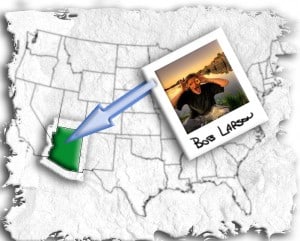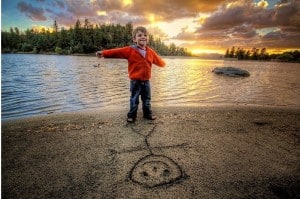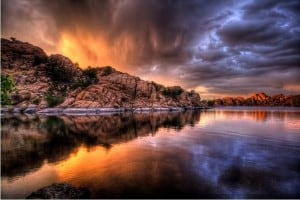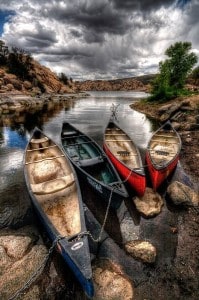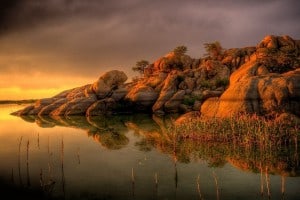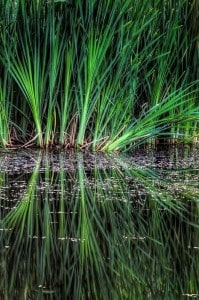As his map profile depicts, this guy is LOADED with enigmatic character. When I first asked him if he would like to be featured on my blog, this was his abridged (Much Abridged) response, “Hello (insert your name here), thank you for your recent inquiry on (insert date here) to boblarsonphoto. We appreciate your business and look forward to processing your request in a timely manner….” At first I was shocked, slightly offended and a little embarrassed, but then I read on, 6 sentences later, “Just kidding Blake, thanks for your interest and I would be honored to be one of your features.” Phew! That was a close one! Bob’s work is as astonishing as his personality. The initial image that drew me toward his work was an HDR image incorporating his son. Check out “Stick Sam” and the interview to follow. As usual, a small sample of Bob’s portfolio and links are listed at the end of the interview. I highly recommend reading through this interview. Bob is a clever individual and his unabridged responses are well worth your read with your morning coffee or afternoon beer!
-What equipment do you use for your HDR process?
- Canon 550D
- Sigma 10-20mm(on my camera 90% of the time)
- Manfrotto tripod and grip head
- Photomatix
- PhotoshopCS4
- Photokit Sharpener
- Imagenomix Noisware
- Nik Color Efex 3
- Rum and Coke
-What level of photographer do you consider yourself?
I consider myself an advanced beginner who tries to pretend he’s more than that. I think I’m going for a record of getting published without getting paid. As of today I’ve been published in our local paper The Daily Courier 78 times, the Phoenix paper The Republic twice, and I’m in the September issue of Arizona Highways this month, and I’ve never been paid for any of it. But it does help with a resume and getting your name out there. I am starting to get approached about photo shoots and just completed one where I shot horses and people on a ranch. The thing about being mainly a landscape photographer is that mountains don’t move, people and horses do, and do a lot. I rented an L lens and felt all professional with it, but I cried when I had to send it back, I’m actually tearing up a little now just thinking about it. I need to stop answering this question now… stupid kit lens!
-What does HDR do for you and your artwork?
It makes me feel like a God in standard dynamic range town. It allows me to laugh at boring saturations and incomplete under defined detail, I crush highlights and give shadow its due. Add that to the fact that I get to deal with traditionalists with a film can stuck up their a__ who point and call me names like “manipulator”, “desecrator”, and “dumbass”(I’m not sure that last one has anything to do HDR though). Traditionalists, I’m sorry you don’t like HDR, and believe it or not, I get it to a certain point. There is a ton of crappy HDR out there, and a ton of people who have no clue how to do it. About the only thing I can think of that is more prevalent than crappy HDR on the internet is super crappy traditional photography. My opinion is that traditional or HDR, it always will come down to the photographers’ eye, composition and the technical ability to service those 2 things. I’ve noticed that most traditionalists are very fond of the word ”slight”, if anything was done to their photo after the shoot it’s always some “slight” adjustments to hue/sat, sharpening, contrast, brightness, curves, and then some “mild” dodging and burning. Guess what, you just manipulated your photo. I went to an exhibit of Ansel Adams(one of my heroes) work at the Phoenix museum recently and they had film of him talking about his process and how he struggled with getting the right amount of exposure through dodging and burning and different dark room techniques, in other words, manipulating. Don’t get me wrong, his stuff straight out of the camera was astonishing, as all first exposures from a bracket should be, but they still weren’t what he saw in his head, and he worked those photos until they were. Does that make him a photographer, a manipulator or an artist? All 3 if you ask me, he made choices that serviced his vision. HDR is a photographic choice to service a vision, with the benefit of still taking the proper traditional exposure. Everything after the proper exposure is a choice. 20 experienced photographers can go to the same mountain with a lake and a gorgeous sunset and they can all get a gorgeous exposure at the proper settings, the thing that will distinguish them from one another is where they chose to shoot from (eye, framing, and composition) and their processing technique. HDR or traditional, the real work is getting there at the right time and knowing what to expect before you get there, and make no mistake, it is work.
What was the original question again? Oh yeah, what does HDR do for me and my artwork.
It allows me to shoot into the sun without filters that I can’t afford.
-Your first run-in with HDR?
When TV first started making the switchover and suddenly the hot co-anchor looked like something from a Rick Baker special effects workshop. Wait, that was HD TV.
The first HDR photos I remember seeing and going,” Holy S__t, I need to know how that was done!” were from David Nightingale at http://www.chromasia.com/. I learned more from his tutorials than I did anywhere else, and not just HDR, some of his Photoshop tutorials are so detailed and head and shoulders over most other ones I’ve read. But what got me to even look at them were the incredible images the guy produces. The other thing is kind of weird and not a joke (oddly enough), but 2 years ago my parents got me the box set of the Planet Earth DVDs for a Christmas present. At the time I’d only been fiddling around with photography with an old Canon A70 point and shoot. I watched the DVDs and my jaw was continually on the floor because of the color, clarity and sharpness of them, let alone the awe inspiring locations and visuals. It got me thinking, “How could you do that with a still camera?” I started researching how it was filmed and how that would translate to still photography and found out my little Canon point and shoot could not possibly suck more. After that I saved up , read up, and got my first DSLR (Canon 400D XTI) and a wide angle lens(Sigma 10-20mm) and I’ve been out in the fields and rocks and cliffs ever since. Come to think of it, what am I doing sitting here typing when I could be shooting…stupid interviews!
-A couple of words about your process (your usual work flow)…
I guess this is where I should be talking about Photmatix and tone mapping, but the truth is none of that matters without a good shot. My process is shoot, shoot, shoot. Learn your environment. If I had a quarter for every time I had someone tell me how lucky I was to be somewhere at the right time I’d have that full frame house with the L glass windows. There is a reason I was at that spot at that time. I’d been in that field, at that lake, in that ditch, behind that lady, a million times before. I had a reasonable, informed idea of what it would look like with those clouds at that wind speed and where the sun would be at that time, and that lady never knew I was there(well until the cops told her..whatever). When I got hired for the horse shoot it was at a place I hadn’t been to before, so I took 2 trips out there just to see the layout, where the light was at the time of day I would be shooting, and what horses look like (side note, they poop a lot). Anyway, that’s my rant on what I think is the most important part of photography.
Okay, after I shoot, I get home (making sure to leave my nasty, skanky, swamp filled boots outside the door), transfer to the computer and look at everything in DPP. I delete whatever isn’t in focus or is just plain bad, or was a stupid idea, or I forgot to take the lens cap off, or I should have left the lens cap on. Once I’ve picked the best ones for HDR, I’ll make sure sharpening has been turned off and most saturation settings are at zero. The next part is a bit of a conundrum for me, I’d be lying if I didn’t say it was kind of fun using the word conundrum, sometimes I process the shots and save them as 16bit TIFFS and sometimes I drag the RAW files directly into Photomatix and let it do the conversion. I’ve found great results with both ways, but I don’t know why yet. If I think it looks off one way, I’ll try it the other way and sure enough that was it. I don’t know why.
In Photomatix, I tend to veer toward negative smoothing, luminosity between half way and full on, black and white points to taste. I don’t really use micro, highlight or shadow smoothing unless there is an emergency situation. Most of the time the strength slider is all the way, unless the scene is too dark. Saturation is to taste, but I tend to go light on it as I will be tending to that more in Photoshop and don’t want to overdo it before hand(which I’ve done roughly 5000 times). Contrast to taste
(which I usually like the taste of).
Once in Photoshop, the first order of business is noise removal. HDR adds a whole bunch of noise, especially if you’re shooting close to dark. The best advice with noise removal is advice that holds true to almost everything you do in Photoshop and what I think is the most important part of the whole process. BE SELECTIVE. I used all caps so I must mean it, or I’m mad. I spend a lot of time trying to capture detail, color, and light in an image, so why do global changes to all of those, when it’s only necessary in part of an image. If there is noise in the sky, take it out of the sky, leave the rock detail alone. If the green of the grass isn’t what it should be, don’t bump the greens in the rest of the image up, same with contrast, brightness, ect… Select the parts of your photos that need the attention, don’t sharpen the whole photo if only one part needs it. Learn to mask.
I think that sums up what I think about the process post Photomatix. After selective noise removal, I’ll do a RAW presharpen using Photokit Sharpener. Next I either work on parts of the image directly in Photoshop or I use Nik Color Efex 3 for various filtering. I came to preferring Nik by utilizing their U point technology which allows you to select only the parts of the image that you want to adjust, and for me that cut down the time I spent on much of my selecting and masking in Photoshop. In Nik I use the tonal contrast, pro contrast, brilliance and warmth, and darken lighten center, polarizer, and graduated neutral density filters the most. Once I’m happy (as happy as I can be, I’ve actually never been very happy with any of them so far) I’ll do selective sharpening with Photokits creative sharpener. It all sounds like a lot, but once you’ve done it a million times it doesn’t take long at all. I usually spend less than 10 minutes from Photomatix to completion in Photoshop.
You said “a couple of words right?” Sorry
-Anything else you would like to add?
In closing, finally! If you can, get yourself a toddler. I learned more about photography from chasing my son around than I learned from researching. I learned angles and odd positions and one of my favorites, a little thing called turning around. I don’t know how many times I was focused on the shot I saw in front of me, to turn around and politely yell at my son not to put that bug in his mouth, only to discover the gorgeous scenery and lighting behind him (not to mention the bug would make for a really cool macro). He also got me out to all these places I photograph, but never knew existed until I had him. Something about having a kid forces you to explore nature, probably your Mom constantly telling you, “it’s a beautiful day, turn off the TV”, like nature wasn’t going to exist after Gilligan screwed up another chance to get off the island!
Photography (HDR or not) is passion, if that’s not coming through, you’re not doing it right, and passion should be there no matter the process.
Can’t Get Enough Of Bob?

